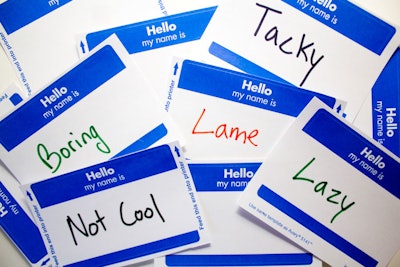
Chad Kaydo (@ChadKaydo) is BizBash’s former editor in chief and the founder and editor of The X Letter, a website and newsletter about experiences, brands, and culture. Chad’s column appears biweekly.
Last week BizBash C.E.O. David Adler posted a column expressing his strongly held opinions about name tags: They should list a person’s name, title, and company, in a point size that can be read from a few feet away without squinting and staring. Seems reasonable.
But at the risk of alienating the person who runs the very site I’m writing for, I feel I have to come forward with my own position on this matter. (You have to take a stand on something, right?)
I’m anti-name tag.
I know they’re necessary at certain types of events—large conferences and trade shows, say, where they serve as credentials as well as memory-helpers when you’re meeting a lot of new people at once.
But most of the time, name tags make a social gathering feel mercenary.
It’s the same reason I don’t like “networking” events, but I love a party where I run into people I know and get introduced to new people and talk about books and apps and vacations and that cool project you’re working on. I like to call that “mingling.” I like to mingle.
Name tags are the perfect symbol of what’s wrong with “networking” events—those people who work the room, scanning people’s badges for a company they want to work for, or sell to, or both.
Is there a tackier opening line than “Oh! You work at…”?
I prefer to start with something more like “What did you think of that speaker?” or “Great party, huh?” before the “How can you help my career?” conversation. I think it’s more fun and more effective to make a personal connection first. And the people who just scan badges, looking for their target companies, leave little room for serendipity—for talking about that great movie we both saw before we figure out how we can help each other (or, really, if we want to).
Still, I realize a big reason we go to events is to meet people, and serendipity doesn’t always facilitate that as well as we’d like.
Neither do name tags.
So if you want get people interacting, I think you should take a more interesting, active approach. Traditional name tags aren’t just tacky. They’re lazy.
“I agree with you that they're not the best way—by far—to get people introduced and interacting,” says meeting facilitator and author Adrian Segar. “Name badges should be an aide-mémoire, a support for a participation-rich event design that helps people to get to know who else is present and their interests, experience, and expertise.”
So here are a few ideas to replace—or at least upgrade—the traditional name tag:
1. Segar, who has a new book in the works called Get On Your Feet: Creating Meetings That Deliver Learning, Connection, Engagement, and Action, says his favorite way to get people introduced is a roundtable session, where all members of a group (of as many as 60) introduce themselves and answer three questions: “How did I get here?” “What do I want to have happen?” “What experience do I have that others might find useful?”
That might take too long for a two-hour cocktail party, but it’s probably worth the time at a multiday conference. (For larger groups, Segar does concurrent roundtables.) Maybe try a shorter version for a shorter party?
2. At its summits for retail executives, Fairchild Fashion Media (publisher of Women's Wear Daily) has projected GIFs of attendees with their company names and contact info around a venue to facilitate networking.
3. What if you had attendees make short videos introducing themselves and explaining what they’d like to get out of your event? They could do them cheaply and easily on Vine, or you could invite the folks at Overture to make their trademark short introduction videos. (They help you write a script and coach your delivery. Here’s mine.) You could post the videos on the event website, or play them at the entrance or behind the bars.
4. The various TED and TEDx conferences have experimented with different kinds of badges, replacing attendees’ names and companies with their personal goals and interests. Badges come with starter phrases like “I’m chasing…”, “Talk to me about…”, or “All we need is…”
5. At an event I hosted in May, I put out name tags with red and blue Sharpies, and asked people to write a favorite brand in red and a favorite artist or performer in blue. Then I asked people to imagine what kind of collaborations their brands and artists might create, or what their favorites might do with another person’s. The point: Encourage conversation around business and creativity, not just your job title.
6. Many of the new technology trends changing live events have applications that can help facilitate introductions and interactions. When signing up for some events, attendees can link their registration information to their social media profiles, and event hosts can help attendees use this information to find each other and set up meetings before the event, or ask to be seated next to each other.
Advanced event apps can also help people share their interests and contact information. And wearables and location-based tools like beacons and R.F.I.D. or N.F.C. technology can alert attendees who have expressed similar interests when they’re near each other. (You can read more about all of these trends in this trend report, “The Next Tech Trends for Live Events & Experiences.”)
7. This one is low-tech, old-fashioned, and oft-forgotten. It’s not scaleable for large events, but it’s the spirit I challenge you to incorporate into a post-name tag world. It’s basic etiquette.
From the “Making Introductions” page on EmilyPost.com: “Try to find some topic the two people have in common: ‘Sam, I think you and Jake share a passion for Italian wine. Jake might enjoy hearing about your wine tour in northern Italy.’”
Classy, right?



















